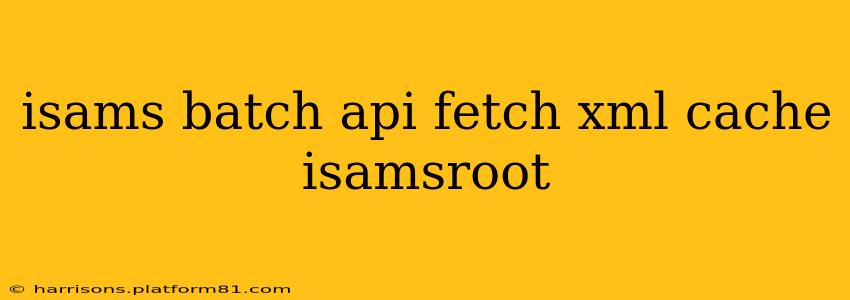Optimizing ISAMS Batch API XML Fetching: Caching Strategies for isamsroot
The efficient fetching of XML data via the ISAMS Batch API, particularly when targeting the isamsroot directory, is crucial for performance and scalability. Raw API calls can be resource-intensive, especially with large datasets. Implementing a robust caching strategy is key to minimizing repeated requests and improving response times. This article explores various caching techniques to enhance your ISAMS data retrieval.
What is the ISAMS Batch API and why is caching important?
The ISAMS Batch API allows for the retrieval of large amounts of data from an ISAMS system in a structured XML format. However, frequent requests, especially to the root directory (isamsroot), can lead to significant server load and slow down application performance. Caching mitigates this by storing previously fetched data, thereby reducing the need for repeated API calls. This is especially beneficial for data that doesn't change frequently.
How does caching work with ISAMS Batch API and isamsroot?
Caching involves storing responses from the ISAMS Batch API to avoid redundant requests. When a request for specific data is made, the system first checks the cache. If the data is present, it's served directly from the cache, significantly improving response speed. Only if the data isn't cached is a new request made to the ISAMS API.
There are several caching strategies you can implement:
1. Local Caching:
This involves storing the XML data on the client-side (e.g., in memory or on the local file system). This is suitable for smaller datasets and applications where data freshness isn't critical. However, data consistency across multiple clients becomes a challenge.
- Advantages: Simple to implement, fast access.
- Disadvantages: Doesn't scale well, data consistency issues across multiple clients, requires careful management of cache invalidation.
2. Server-Side Caching:
This method stores the cached data on a server. This allows for easier sharing of cached data amongst multiple clients and simplifies cache invalidation management. Common server-side caching mechanisms include using dedicated caching servers (e.g., Redis, Memcached) or leveraging built-in caching features in your application framework.
- Advantages: Improved scalability, better data consistency, centralized cache management.
- Disadvantages: More complex to set up and manage than local caching.
3. CDN (Content Delivery Network) Caching:
For larger-scale deployments, a CDN can dramatically improve performance by caching the data closer to the end-users. CDNs are particularly beneficial for geographically distributed users.
- Advantages: Reduced latency, improved scalability, increased availability.
- Disadvantages: Higher setup and maintenance costs.
How to implement caching for ISAMS Batch API requests to isamsroot?
The specific implementation depends on your chosen caching strategy and technology stack. Here's a general approach:
- Identify frequently accessed data: Analyze your application's usage patterns to determine which portions of the
isamsrootdata are accessed most frequently. - Choose a caching strategy: Select the appropriate caching mechanism based on your scalability requirements and resources (local, server-side, CDN).
- Implement cache invalidation: Develop a strategy for removing outdated data from the cache. This is crucial to maintain data consistency. Consider using time-based expiration, or checking the last-modified timestamp of the data from the ISAMS API.
- Monitor cache performance: Track cache hit rates and response times to fine-tune your caching strategy.
What are common caching strategies for XML data?
Common strategies include:
- Full-page caching: Cache the entire XML response. Simple but less flexible for partial data updates.
- Fragment caching: Cache specific portions of the XML response. More flexible for partial updates but more complex to manage.
- Object caching: Cache individual XML elements or objects. Provides fine-grained control and flexibility but is more complex to implement.
By carefully implementing a caching strategy, you can significantly improve the performance and efficiency of fetching XML data from the ISAMS Batch API, especially when targeting isamsroot. Remember to choose a strategy that aligns with your specific needs and resources. Regular monitoring and optimization are crucial for maintaining optimal performance.
